Zermatt is a compact alpine village tucked away high up in the south of Switzerland, not far from the Italian frontier. At an elevation of 1,608m (5,276 feet) it is encircled by 29 inspirationally sculptured 4,000m peaks – an impressive line-up of giants including the Dent Blanche, Weisshorn, Dom, Taschhorn, Ober Gabelhorn, Zinalrothorn, Monte Rosa and of course, the world-famous and much photographed Matterhorn. Over time, the Zermatt region has evolved into a veritable Shangri-La for both winter and summer mountain activities.
People have lived in Zermatt for centuries; around 150 years ago, the inhabitants were mainly farmers raising cattle, tending a few crops and hunting game in the forests. At the beginning of the 19th century, visitors began arriving in Zermatt in order to explore and climb the mountains or to study the flora and geology of this remote environment. As a result of such interest, hotels began opening in the village and some of the locals took to looking after these new tourists, including guiding them around the unique glacial valleys and mountains.
On my visits to Zermatt over many years, I have always stayed at the Aristella Hotel; the owners, Katja and Bernard Perren-Tenisch, are able to illustrate these historical changes. They can trace their ancestry back generations to when farming was the mainstay and to when guiding first began. Indeed, many past family members helped outsiders during the first ascents of the surrounding mountain peaks during the 19th century.
An event that put the Zermatt valley well and truly on the world stage was the first ascent of the Matterhorn in 1865. The exploration and climbing of the major mountains was being led predominately, both in Zermatt and throughout the Alps, by the British upper classes of the day.
To climb an alpine peak was very much on the agenda of this group who had both the means and the time to spend on such adventures. Of course, local guides accompanied these expeditions and were central to any success. This was the birth of alpinism and it became known as the “golden age of mountaineering.” However, the last piece in the jigsaw of completing the first ascents of all the most important alpine summits, was the illusive Matterhorn.
With its imposing faces and vertical ridges, both the inhabitants living beneath its shadow and visiting outsiders, believed it to be impossible to climb. An ascent of the Matterhorn had become an obsession of one particular Englishman named Edward Whymper. After learning that his Italian guide, Jean-Antoine Carrel had betrayed him and had already set off to climb the Matterhorn from the Italian side, the Englishman quickly rushed to Zermatt on the Swiss side in order to mount a counter-attack. It became a race to the top, which ended in Whymper’s seven-member team waving and shouting triumphantly at the Italian group far below. Unfortunately, during the conquerors’ descent, three Englishmen and a guide fell to their deaths leaving two other guides and Whymper alive on the safe side of a broken rope. The tragedy came as a great shock throughout the Alps and beyond, illustrating that climbing mountains was indeed a very dangerous pastime.
Over the years, increasing numbers of visitors have been drawn to Zermatt; in 1839 there were just 60 recorded overnight guests but by 1895, it had risen to 86,000. First with an improved road and later by a remarkable narrow-gauge railway, which opened in 1891, it became easier for travelers to reach Zermatt.
More and more of the well-to-do were enjoying summers both walking and climbing in these mountains. However, at the beginning of the winter months, the village and its facilities for the growing numbers of tourists simply closed down until the next summer. Over the following decades, this would all change.
The first skiing was recorded in 1898 when two visitors skied from the slopes of Monte Rosa. Over time this activity steadily developed and in 1927, the first hotel opened for winter guests. Winter visitors increased in number so by the 1970s, 60 percent of all visitors to the village in that year were arriving solely for winter activities—this ratio of winter to summer visitors has remained more or less the same to the present day.
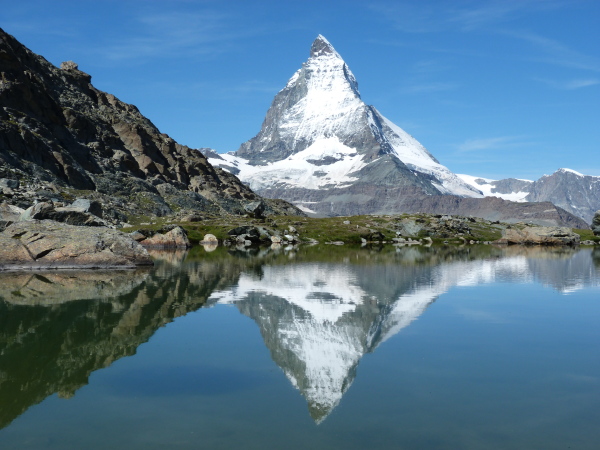 Today, Zermatt is a world-famous and sophisticated downhill skiing resort with over 360 kilometres off piste. There are cable cars, gondolas, an overland railway line up to 3,089 metres (10,135 feet) and an underground funicular railway, which are all used to transport skiers during the winter season. It is even possible to ski over into Italy and then return to Zermatt by using interconnecting pistes and lifts. In addition to all the down-hill skiing, there are some cross-country skiing and some winter hiking trails to be enjoyed. And, there are a few designated snowshoe routes in the area for which there are maps available and information boards at the beginning of routes. To help snowshoers on these trails, every 100 meters are marked by pink poles.
Today, Zermatt is a world-famous and sophisticated downhill skiing resort with over 360 kilometres off piste. There are cable cars, gondolas, an overland railway line up to 3,089 metres (10,135 feet) and an underground funicular railway, which are all used to transport skiers during the winter season. It is even possible to ski over into Italy and then return to Zermatt by using interconnecting pistes and lifts. In addition to all the down-hill skiing, there are some cross-country skiing and some winter hiking trails to be enjoyed. And, there are a few designated snowshoe routes in the area for which there are maps available and information boards at the beginning of routes. To help snowshoers on these trails, every 100 meters are marked by pink poles.
During the summer months the Zermatt area continues to receive visitors who appreciate the exceptional mountain environment. Tourists make use of the mountain transportation systems allowing people to quickly get up high by using the trains and cable cars.
There are around 400 kilometres of hiking trails in the Zermatt area. Information materials and good signs help hikers find their way around the varied trails placed at all elevations on the mountainsides. Visitors are able to enjoy the truly breathtaking mountain vistas of snow-capped peaks and glaciers in addition to searching out a huge variety of alpine flowers and fauna such as chamois, ibex and marmots. It is also the main season for climbing: during the summer months, numerous mountaineers arrive in Zermatt to ascend the summits using a variety of routes on snow, ice and rock. Other popular summer activities include mountain biking on designated trails and summer skiing on glaciers beneath the Klien Matterhorn.
So, Zermatt has become an important centre for mountain activities. The inhabitants of this village are very careful to maintain their status as a world centre for mountain sports but remain conscious that any future tourist developments must be balanced with caring for the very environment that visitors come to enjoy. Long may this mountainous area remain an attraction, so wherever you venture forth in the Zermatt region and whatever activity you might be enjoying, your eyes will continue to be drawn towards the breathtaking vistas surrounding this alpine village.
For further Zermatt information:
www.zermatt.ch
www.alpincenter-zermatt.ch
www.aristella-zermatt.ch
A Selection of the Best Zermatt Hiking Trails in Switzerland
The mountains around the village of Zermatt in the south of Switzerland, have some 400 hiking trails which act as a magnet for summer visitors to this corner of the Alps. Many of the paths are easily accessed because hikers, if they so wish, may take advantage of the mountain transportation system, which has been constructed for winter skiing.
The many trails take you through a variety of landscapes including alpine forests, by glaciers and their moraines, under towering snow-capped peaks, across alpine alms with a multitude of wild flowers and by lakes of still waters reflecting distant summits. It is a place to relax and enjoy an awe-inspiring mountainous environment.
I first walked in these mountains as a student in the early 1970s and have been returning, intermittently, ever since. Although all trails in the area possess great appeal, below are a personal selection of walks that have exceptional character and display distinct aspects of this unique alpine environment. All walks are well sign-posted. Most of them may be completed in either direction, especially if mountain transportation is used, therefore an increase or loss of elevation might need to be considered.
- Blauherd – Tufteren – Zermatt
This walk has been chosen as a warm-up and as an introduction to these mountains. Take a gondola to Blauherd and then follow the signs to Tufteren on the Blumenweg Trail. You will soon find yourself walking through a variety of alpine flowers and enjoying distant views.
Look out for marmots eating or soaking-up the sun. Within an hour you will be just above the forest line, approaching a cluster of traditional alpine huts at Tufteren. There you might wish to refresh yourself with a drink and sample some of the local cheese (arguably the best in the Alps) at a path-side mountain-hut cafe in Tufteren. Then continue down through the forest to Zermatt, listening out for the chattering cackle of lone nutcracker birds as they fly amongst the trees collecting pine cone seeds.
- Gornergrat – Rotenboden – Riffelberg – Riffelalp
This walk may also be completed in sections, if preferred, as the trail meets with the Gornergrat mountain railway at various points. As with the previous walk, it might serve as a warm-up to your hiking holiday. Starting at the terminus of the Gornergrat cogged railway line at 3,089 metres (10,135 feet) hikers merely need to begin walking downhill following the signs to Rotenboden. Keep to the left and enjoy the views of the long Gorner Glacier far below with its tributary glaciers and a line of mountains that include left to right, Monte Rosa, Lyskamm, Castor, Pollux and the Breithorn.
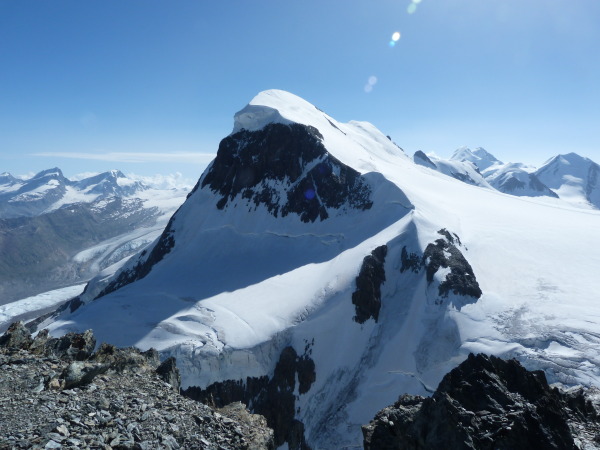 Keep your eyes peeled for mountain ibex that roam in this vicinity. At Rotenboden, there is a station; continue walking but stay to the left following signs to Riffelberg. It is at this point that people spend time photographing reflections of the Matterhorn in the small lakes of Riffelsee. Walking on, keep to the left at all junctions but continue to follow signs to Riffelberg. To your left will be the rock climbing peak of Riffelhorn as you walk down the rocky path with an increasing number of alpine flowers coming into view. Eventually, you will arrive at Riffelberg (with a station) where you then need to follow the zig-zag path down to Riffelalp. Enjoy the distant views of the moraines of a receding Zmutt Glacier below the Matterhorn. At Riffelberg you can catch a train or you could continue down through the forest to Zermatt.
Keep your eyes peeled for mountain ibex that roam in this vicinity. At Rotenboden, there is a station; continue walking but stay to the left following signs to Riffelberg. It is at this point that people spend time photographing reflections of the Matterhorn in the small lakes of Riffelsee. Walking on, keep to the left at all junctions but continue to follow signs to Riffelberg. To your left will be the rock climbing peak of Riffelhorn as you walk down the rocky path with an increasing number of alpine flowers coming into view. Eventually, you will arrive at Riffelberg (with a station) where you then need to follow the zig-zag path down to Riffelalp. Enjoy the distant views of the moraines of a receding Zmutt Glacier below the Matterhorn. At Riffelberg you can catch a train or you could continue down through the forest to Zermatt.
- Blauherd – Stellisee – Grindjesee – Gruensee – Riffelalp
After a rail journey through the mountain at Sunnegga and a gondola ride, the trail begins at Blauherd. At the cable car station, follow the signs on a path signposted Stellisee. This footpath meanders between boulders amid a variety of delicate alpine flowers – look out for edelweiss. In front of you will be the peaks of Rimpfischhorn, Strahlhorn and Adlerhorn. Continue to Stellisee Lake where you might observe numerous fish warming in the shallow waters at the edge.
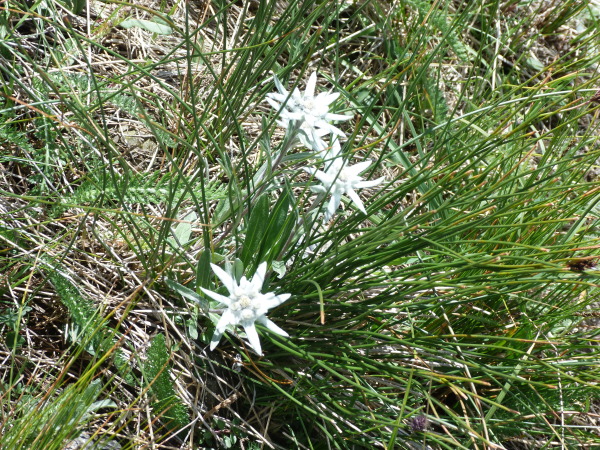 On the far side of Stellisee you might be lucky to catch an artistic reflection of the Matterhorn. Follow signs down to the lower Grindjesee Lake for further mountain reflections, a waterfall with a scattering of trees and wild flowers. Moving along, you need to follow signs to Gruensee Lake. On the way you will see huge moraine features to your left and smaller lakes with alpine orchids growing beside moist streams. At Gruensee Lake, you enter a forest of larch trees and ancient arolla pines on your way to your destination at Riffelalp.
On the far side of Stellisee you might be lucky to catch an artistic reflection of the Matterhorn. Follow signs down to the lower Grindjesee Lake for further mountain reflections, a waterfall with a scattering of trees and wild flowers. Moving along, you need to follow signs to Gruensee Lake. On the way you will see huge moraine features to your left and smaller lakes with alpine orchids growing beside moist streams. At Gruensee Lake, you enter a forest of larch trees and ancient arolla pines on your way to your destination at Riffelalp.
- Rothorn – Oberrothorn – Tufteren
This route takes you on what is publicized as ‘ the highest hiking trail in Europe’ at 3,415 metres (11,204 feet). Take the cable car to Rothorn and walk downhill following the signs to Oberrothorn. It will soon take you onto a zig-zag path, which works its way uphill with distant views of the huge glacial plateau below Cima di Jazzi. The path will eventually reach a rocky ridge with rugged rock pinnacles; continue upwards to the top of the Oberrrothorn.
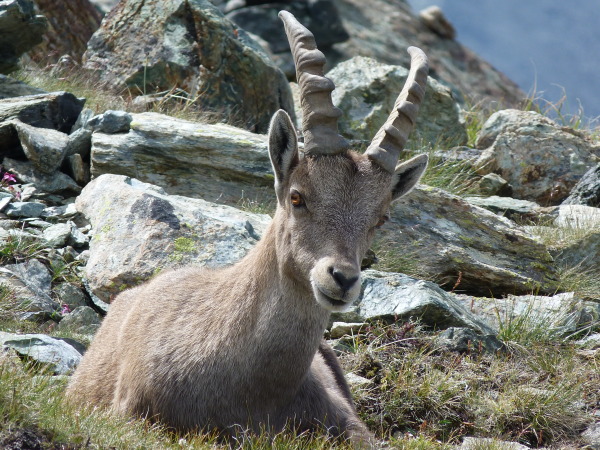 From the summit bathe in the view of both near and far mountain tops in all directions – especially noticing to the north-east the pointed Dom and Taschhorn. Reverse the route back down to beneath the Rothorn cable-car hill. At this col, follow the signs on your right to Tufteren on the Gamesweg trail. Walking down this valley look-out for chamois or ibex grazing high up to your right and the increasing numbers of wild flowers including edelweiss. Once at Tufteren, you can continue on down to Zermatt or walk to Sunnega or refresh yourself with some more cheese at the Tufteren Hut.
From the summit bathe in the view of both near and far mountain tops in all directions – especially noticing to the north-east the pointed Dom and Taschhorn. Reverse the route back down to beneath the Rothorn cable-car hill. At this col, follow the signs on your right to Tufteren on the Gamesweg trail. Walking down this valley look-out for chamois or ibex grazing high up to your right and the increasing numbers of wild flowers including edelweiss. Once at Tufteren, you can continue on down to Zermatt or walk to Sunnega or refresh yourself with some more cheese at the Tufteren Hut.
- Trockener Steg – Schwarzsee
This trail doesn’t fall below 2,500 metres (8,200 feet). At Trockener Steg gondola station follow the signs for the Matterhorn Glacier Trail. The first part of this hike meanders up and down glacial moraine and over rocks just below the Furgg Glacier. Further on, the path descends through boulders and moraine debris. The path will then follow a melt-water stream, go over a bridge, up quite steep moraine before a final descent down to Schwarzsee. What makes this walk unique is that it displays a host of glacial features along with providing a continually close-up view of the Matterhorn throughout the journey. Choose good weather and you will be continually stopping to take those amazing shots.
- Schwarzsee – Hornli Hut
As alpine hikes go, this is a classic, with exceptional views and indescribable atmosphere.
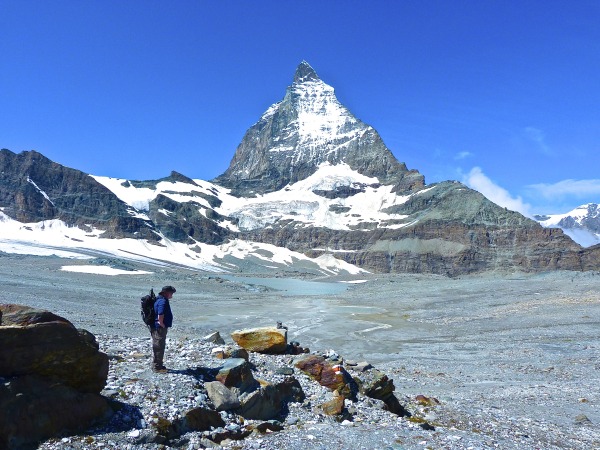 Begin at Schwarzsee and follow the signs to the Hornli Hut. At a junction where the path branches off to Trockener Steg, continue upwards onto the metal walkway and steps, which have been fixed to a rock face. Follow zig-zags up to a flat section of the trail for around one kilometre (2/3 mile). The final part of the route zig-zags steeply uphill, eventually to the Hornli Hut. Just above the hut, you will be able to watch climbers descending from the great mountain. For the entire length of the walk, there are endless views of the Matterhorn, from changing angles and from close quarters. Look out for good views of the Dent Blanche, Ober-Gabelhorn and the Zinalrothorn. Return to Scwarzsee the same way. As an alternative, once below the metal walk-way, you could take the path that leads up to Trockner Steg.
Begin at Schwarzsee and follow the signs to the Hornli Hut. At a junction where the path branches off to Trockener Steg, continue upwards onto the metal walkway and steps, which have been fixed to a rock face. Follow zig-zags up to a flat section of the trail for around one kilometre (2/3 mile). The final part of the route zig-zags steeply uphill, eventually to the Hornli Hut. Just above the hut, you will be able to watch climbers descending from the great mountain. For the entire length of the walk, there are endless views of the Matterhorn, from changing angles and from close quarters. Look out for good views of the Dent Blanche, Ober-Gabelhorn and the Zinalrothorn. Return to Scwarzsee the same way. As an alternative, once below the metal walk-way, you could take the path that leads up to Trockner Steg.
- Zermatt – Edelweiss Hut – Trift Hut – Hobalmen
It is possible to get away from the mountain transportation system by walking on the western side of the Zermatt, up into the Trift valley. Begin this walk in the centre of Zermatt at Grampi’s Cafe and walk to the side of the building taking the Trift path upwards out of the village. Follow the signs for the Trift Hut.
The zig-zag path will take you through trees and by a waterfall to the Edelweiss Cafe, which overlooks Zermatt. Once there, continue walking through wild flowers to more zig-zags taking you to the Trift Hut. Look-out for ibex living along this valley. The Trift valley is a very quiet and perfect place to enjoy mountain tranquility. There are several junctions at this point; you could return the same way or continue on to Hohbalmen. The route zig-zags up above the Trift Hut with views of the mountains and glaciers towering above. Eventually, the path will reach Hohbalmen from where you can gaze at an entirely different perspective of the Matterhorn and Dent d’Herens further on. From this point you can return the same way or via Zmutt (well sign-posted but a longer walk).
If you do manage to visit Zermatt, you might wish to try some of these walks. Remember, there are around 400 kilometres of summer trails many of which are easily accessed. Enjoy!

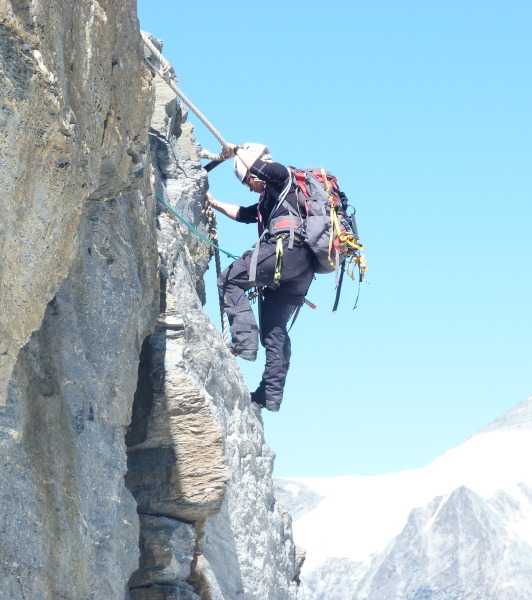
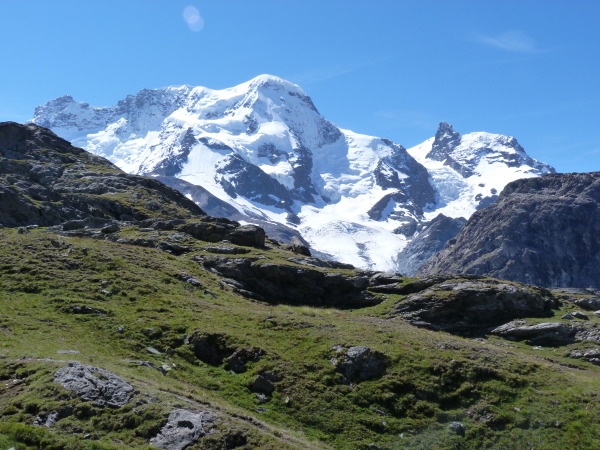
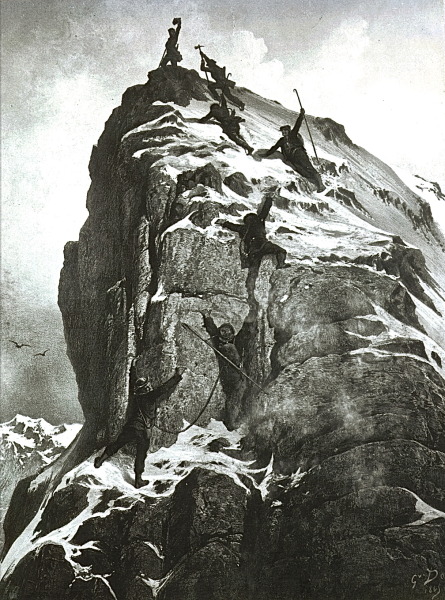
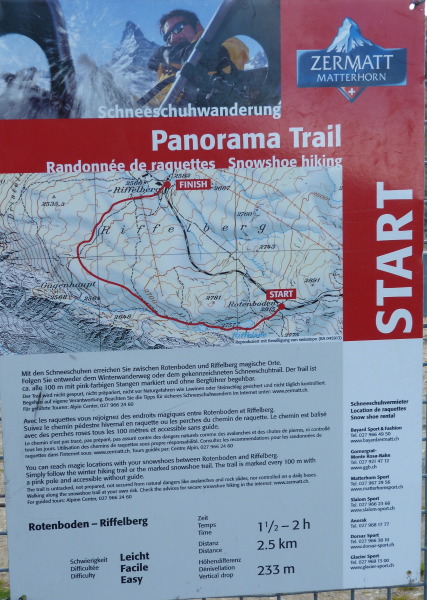
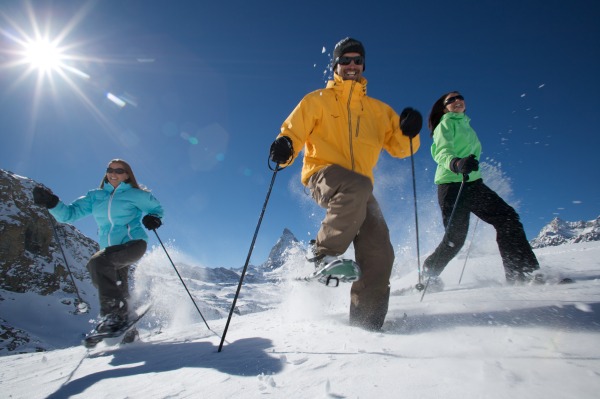
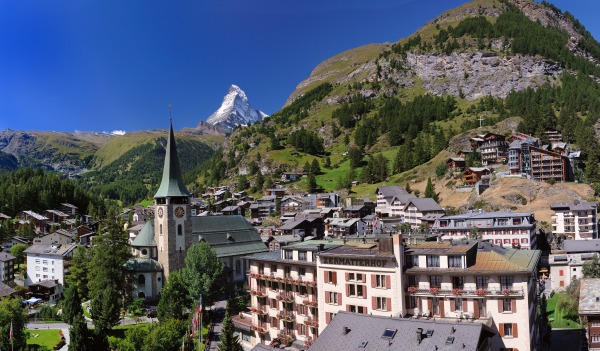
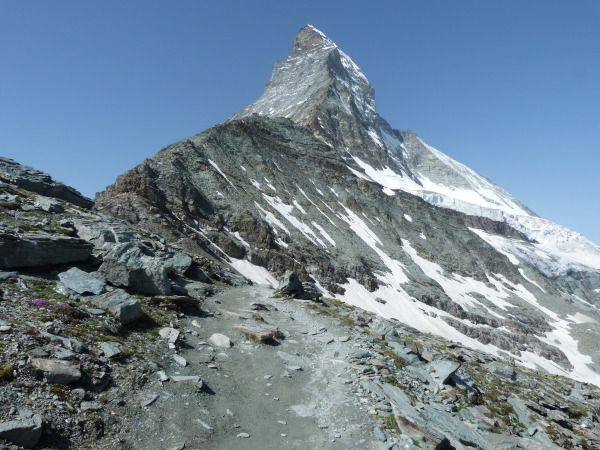
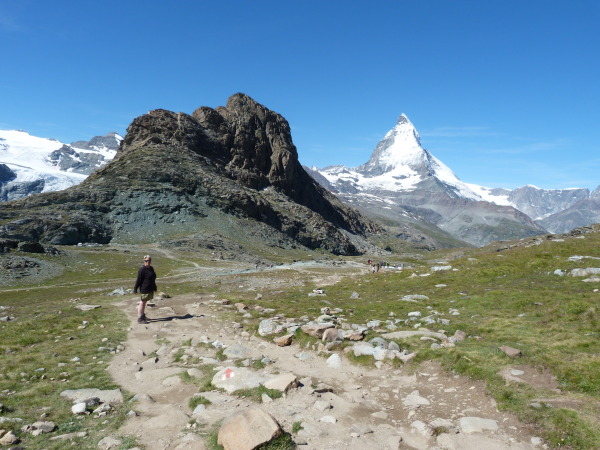
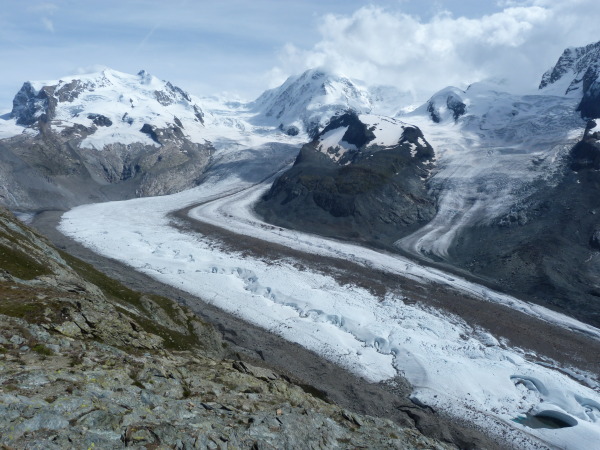
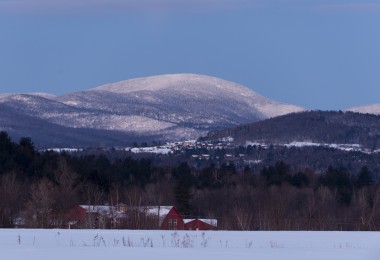
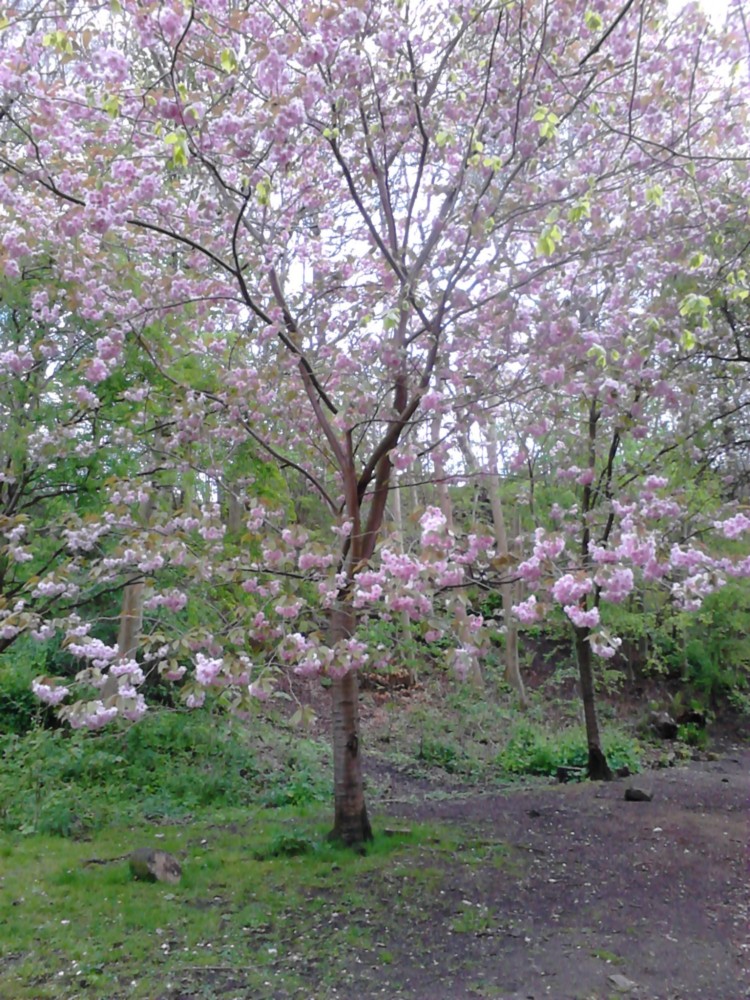
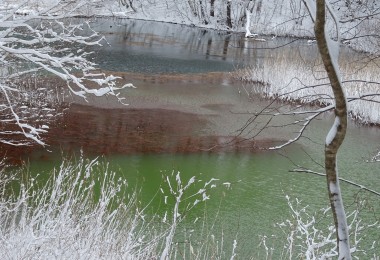
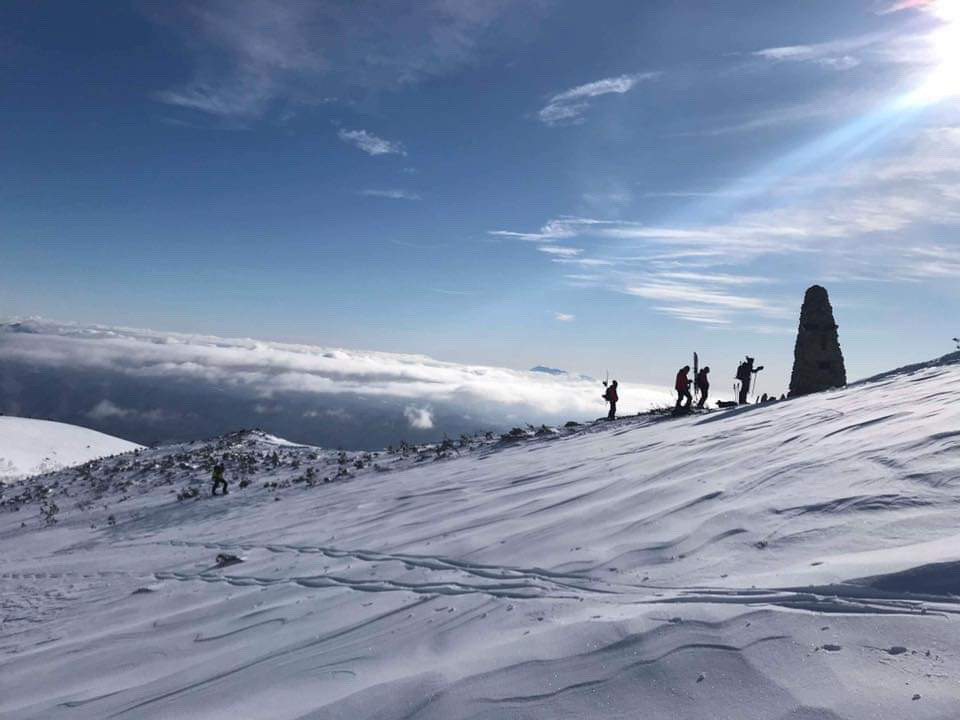

Just brilliant. I’m not much of a winter animal myself, but I find these articles about tall, cold peaks exhilarating. Must get over there at some point.